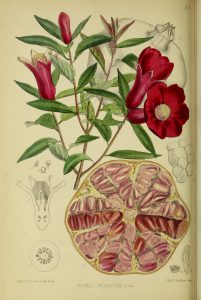 The Health Sciences and Human Services Library Historical Collections’ strives to provide broad access to our diverse collections both in person and digitally. Materials in our collections appear as they originally were published or created and may contain offensive or inappropriate language or images and may be offensive to users. The University of Maryland, Baltimore does not endorse the views expressed in these materials. Materials should be viewed in the context in which they were created.
The Health Sciences and Human Services Library Historical Collections’ strives to provide broad access to our diverse collections both in person and digitally. Materials in our collections appear as they originally were published or created and may contain offensive or inappropriate language or images and may be offensive to users. The University of Maryland, Baltimore does not endorse the views expressed in these materials. Materials should be viewed in the context in which they were created.
Lemons, oranges, pomegranates, these are all fruits associated with winter and the holiday season. Today we eat them as desserts or in desserts or in cocktails. These fruits bring a sense of freshness to the winter months. While today these fruits are important for a balanced and flavorful diet; in the 17th through the early 19th centuries, these fruits were often prescribed in botanicals for a variety of medicinal purposes. Botanicals are a form of book published to illustrate plant species and their medicinal value. The HSHSL’s Historical Collections Department is home to a large collection of Botanicals as part of our historic Pharmacy Collection. These volumes were used by the early UMB schools to teach pharmacists and doctors the value of plants for medicinal purposes.
This post looks at two botanicals available in Historical Collections. Through William Woodville’s, Medical Botany, and Robert Bentley’s, Medicinal Plants, we can uncover early medicinal uses for winter fruits, such as citrus, pomegranate, and currants.
William Woodville (1752-1805) was a physician and botanist from England. Medical Botany… is a four-volume set published between 1790 and 1794. It includes 300 plant illustrations by James Sowerby. Through the 20th Century these beautiful volumes were heavily used and referenced by physicians.
Robert Bentley (1821-1893) was a botanist from England. Medicinal Plants… is a four-volume set published in 1880 with Henry Trimen. Trimen (1843-1896) was also an English botanist. The set includes over three-hundred plates with plant illustrations by David Blair. A complete set of Bentley and Trimen’s Medicinal Plants have also been digitized in the UMB Digital Archive.
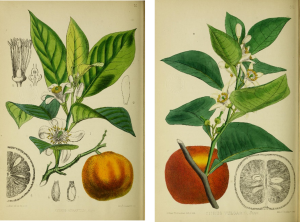 Citrus Aurantium & Citrus Vulgaris
Citrus Aurantium & Citrus Vulgaris
Common names: Orange, Bitter Orange, Seville Orange, Bigarade Orange, Sweet Orange, China Orange, Portugal Orange
Citrus Vulgaris or the bitter orange was originally grown on small trees in the Mediterranean, Spain, Madeira, India, and China. The peel of this variety of orange is aromatic and was used as a tonic or stimulant. When added to bitters it hid the taste of other medicines.
Citrus Aurantium or the sweet orange’s original home was in Northern India and Southern China. It was introduced to Europe by the Portuguese in the 15th century and then grown abundantly in the Mediterranean, as well as Spain, Portugal, Madeira, Azores, and China. Orange Flower Water and Oil of Neroli were both produced by the tree. The water was used as a nervous stimulant or flavoring agent, while the oil was used in perfumes and the preparation of liqueur. The peel also had aromatic stimulant properties and was used for its flavor or in tonic and purgative medicines.
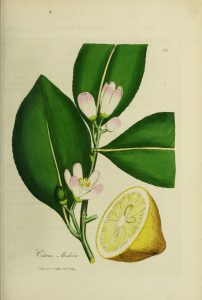 Citrus Medica
Citrus Medica
Common name: Lemon Tree
Citrus Medica flowers in the summer and is native to upper parts of Asia. It was later introduced to Greece and Italy and then to Spain, Portugal and France. Lemons were used in medicine to restrain vomiting, to prevent scurvy, reduce heart palpitations, and remedy jaundice.
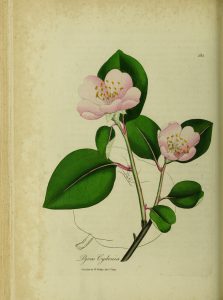 Pyrus Cydonia
Pyrus Cydonia
Common name: Common Quince Tree
Pyrus Cydonia produces an apple or pear-like fruit known as a quince. The fruit is divided at the center into five cells, which contains seeds. The flowers are large, solitary, and either pale red or white. The trees are native to Austria and were known to grow wild on the banks of the Danube River. The quince has a pleasant odor and the juice was used for medicinal purposes. The juice was cooling, it would restrict blood flow and secretion of fluids, and was useful in cases of nausea and vomiting.
Common name: Pomegranate
Punica Granatum is a bush or small tree producing fruit the size of an orange with numerous edible seeds. Pomegranate was native to North Western India, Southern Persia, and Palestine before it was introduced to the Mediterranean countries in Europe and North Africa as well as China. The root bark and rind of the fruit were used as a remedy for diarrhea and dysentery. The bark was also used to treat tapeworm and the rind and flower was used in dyeing and tanning leather.
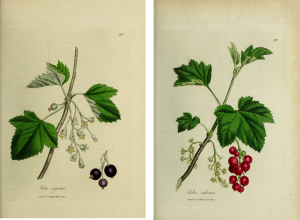 Ribes Rubrum & Ribes Nigrum
Ribes Rubrum & Ribes Nigrum
Common names: Red Currant, White Currant, or Black Currant
Ribes Rubrum or the red and white currant is a shrub that grows to five or six feet in height. The fruit was used to cool the body and help thirst. It was also prescribed as an antiseptic and used as a diuretic to relieve constipation.
Ribes Nigrum or the black currant grows on a tree of six to seven feet. Native to Britain, the fruit was larger than the red or white currant and was used for sore throats and for its diuretic power.
The Pharmacy Collection in the HSHSL’s Historical Collections contains influential pharmacy and medical texts, as well as dispensatories, pharmacopoeias, botanicals, and herbals from around the world. The volumes date from the seventeenth to the twentieth centuries. Many, including Robert Bentley’s text are available through the UMB Digital Archive. Additionally, images from Woodville’s Medical Botany were used in the Library’s 2020 Coloring Book.


